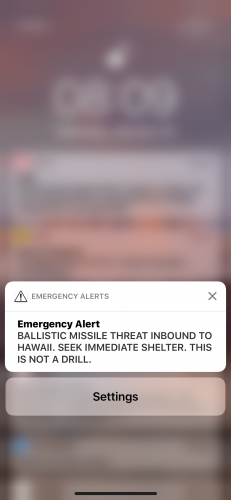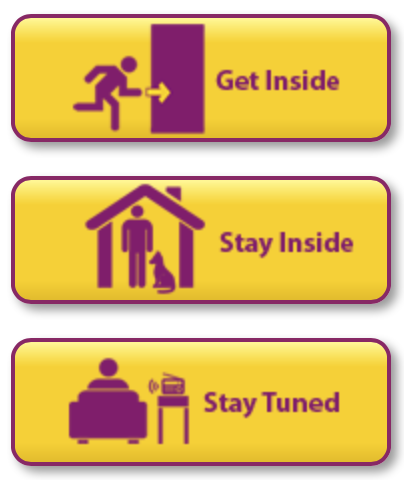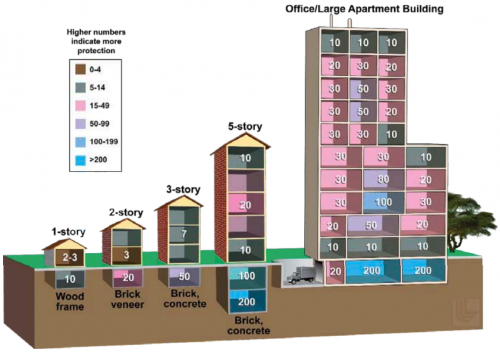Nuclear Preparedness

Although a nuclear attack is extremely unlikely, recent news has brought this issue to the public’s attention. As with all threats, preparation is important. A nuclear attack can occur if an enemy state or terrorists deliberately fire a missile armed with a nuclear weapon at a city, military base, etc., or transport a nuclear weapon into such an area in order to cause mass casualties. While recent developments in North Korea’s nuclear and missile programs have made more people aware of such threats, nuclear preparedness has long been a component of all-hazards preparedness and emergency officials in Hawaii have included it as part of their planning for many years.
The prospect of a nuclear attack hit home for many in Hawaii on the morning of Saturday, January 13, 2018, when people across the state received an emergency alert stating that a missile headed for the islands had been detected and they should seek immediate shelter. The emergency alert turned out to have been a mistake, but a lot of people were emotionally shaken. Many did not know what to do in the event of an actual attack, while others realized that they did not have adequate emergency supplies.
Public health preparedness focuses both on preventing disasters and preparing for them. For nuclear preparedness, there are two important components that the public should be aware of: what to do in case of an attack, and how to prepare for this or any other man-made or natural disaster. These significantly raise your chance for survival and they are both addressed below.
Impact in Hawaii
- Hawaii is one of the closest parts of the United States to North Korea, possibly making its population centers more vulnerable to the threat of nuclear attack. A nuclear detonation anywhere in Hawaii would be devastating. Long before the recent threats made by North Korea, the State of Hawaii began to implement a plan to educate the population on what they can do to raise their chance of survival in the unlikely event of a nuclear attack.
- These preparations included setting up a new emergency siren, specifically for a missile attack, which was first heard on December 1, 2017. This will be accompanied by education for residents of Hawaii to “get inside, stay inside, and stay tuned.”
What can I do?
UNDERSTAND THE DANGER
- It is important for the public to understand the dangers of a nuclear attack and what they can do to raise their chances of surviving and avoiding injury and long-term illness. Despite concerns during the Cold War that an all-out nuclear war would bring total destruction, an attack by a single nuclear device would bring considerably less loss of life. In fact, if a nuclear bomb the size that North Korea is currently suspected to have were detonated even on Oahu, the vast majority of residents would be expected to survive.
 People closer to the blast would be able to reduce their risk of harm if they heed the advice to “get inside, stay inside, and stay tuned” as soon as they hear the new missile attack siren. This means that they should immediately head for the nearest solid structure (e.g., a concrete structure that can withstand the blast unleashed by a nuclear explosion) and stay there. Getting into a basement and/or the center of a building reduces exposure to nuclear fallout following an explosion; the more material separating you from outside air, the greater the chances of survival.
People closer to the blast would be able to reduce their risk of harm if they heed the advice to “get inside, stay inside, and stay tuned” as soon as they hear the new missile attack siren. This means that they should immediately head for the nearest solid structure (e.g., a concrete structure that can withstand the blast unleashed by a nuclear explosion) and stay there. Getting into a basement and/or the center of a building reduces exposure to nuclear fallout following an explosion; the more material separating you from outside air, the greater the chances of survival.- A nuclear blast would cause a radiological emergency. Although people are exposed to very small amounts of radiation every day (such as by the sun, uranium in the soil, or from manmade sources such as x-ray machines and microwave ovens), a radiological emergency caused by a nuclear blast could expose people to large amounts of radiation that can endanger their lives. Exposure to very large doses of radiation may cause death within a few days or months; exposure to lower doses of radiation may lead to an increased risk of developing cancer or other adverse health effects years in the future. It is for this reason that it is important to stay sheltered in the first 48 to 72 hours after a nuclear attack, until there is information that it is safe to come out and/or go elsewhere.
- In a radiation emergency, officials will monitor the amount of radiation and advise the public what to do. When it is safe to leave shelter depends on a number of factors, including distance from the blast, weather conditions, terrain where you are (flat or mountainous), etc.
- As with other potential disasters, it’s important to keep a two-week emergency supply kit that includes 1 gallon of water per day per person, non-perishable food, medication, and other important items. It is also important to have a family emergency plan so that you and your loved ones will know what to do and where to go in case of a disaster. For more information on protecting your family, click HERE.
What happens in a nuclear explosion?
Initial effects
- A nuclear explosion is powerful and deadly. The initial blast produces an intense flash of light that will blind anyone looking directly at it. This is followed by extremely powerful shock waves that will destroy virtually everything in the immediate area and cause massive destruction even miles away, including buildings, roads, airports, harbors, and other infrastructure that the public relies on. The explosion also produces intense heat and radiation that can ignite fires and cause severe burns in unprotected people. People within 2 to 3 miles of a nuclear blast who are unsheltered are unlikely to survive.
- A nuclear blast can cause damage in other ways as well, including an electromagnetic pulse (EMP). An EMP cannot injure you, but it can temporarily or permanently disrupt electronic items, including vehicles, radio and televisions, and other devices.
Delayed effects
- Those who survive the initial effects of the nuclear blast are still at risk due to other dangers, particularly radioactive fallout. Fallout is created when a nuclear blast occurs near the surface of the ground and is a mixture of debris from the explosion and radioactive material from the weapon. Fallout looks like fine sand, and as it falls to the earth, it settles on horizontal or flat surfaces, such as rooftops, driveways, roads, and open areas.
- Most fallout settles to the surface of the earth within 24 hours, but it can be dangerous longer than that. Sheltering for at least the first 48 to 72 hours after an attack is crucial because of fallout. If someone does get covered with fallout, it is important to get rid of it as much as possible before entering a shelter, by dusting it off and/or removing exposed clothing before entering a shelter. If possible, the exposed person should thoroughly wash themselves off (with soap and water, if available) after entering the shelter. For more on self-decontamination, go HERE.
- If you are seeking shelter inside, so should your pets. Pets that have been outdoors in fallout should also be cleaned, with soap and water if available. For more on decontaminating your pets, go HERE.
- It is safe to eat or drink packaged food items or items that were inside a building during the fallout. Do not consume food or liquids that were uncovered outdoors and may be contaminated by fallout.
- Further information about the health effects of radiation can be found HERE. More information about protecting yourself and your loved ones from fallout is in the sections that follow.
KNOW WHAT TO DO BEFORE, DURING, AND AFTER AN ATTACK
- Your actions should be focused on three things: preparing before an attack, surviving during an attack, and being safe after an attack.
Preparing Before an Attack
Prepare a kit
- The likelihood of a nuclear attack is extremely low, but Hawaii is vulnerable to other types of natural and manmade disasters. The best way to protect yourself and your loved ones if disaster strikes is by planning ahead of time and being prepared. Because of our state’s isolation thousands of miles from the US Mainland, authorities in Hawaii recommend that everyone prepare at least a 14-day “survival kit” that includes water, food, medication, first-aid supplies, and other essentials for every member of your household to last at least two weeks. In a severe disaster, such as a nuclear attack or a severe hurricane, it can be days or even weeks before help arrives, so such a survival kit is crucial. The Department of Health has detailed information about how to put together and maintain a disaster kit at THIS LINK.
Know where to go
- In addition to putting together a survival kit, it’s important to know ahead of time where you will go in case of a disaster. In the event of a major hurricane or other natural disasters, government agencies might open up shelters for people in danger or those whose homes have been damaged, but at this time there is no network of nuclear fallout shelters that are maintained with supplies. Also, if a missile is detected and believed to be heading for Hawaii, there would be too little time for most people to head for a shelter, even one in their neighborhood.
 Instead, emergency guidelines suggest going into a solid structure (e.g., one made of cement, brick, or other material that can help shield from radiation) in the immediate area, if there is an immediate threat of a nuclear attack. It is helpful to plan ahead of time what building you will head to around your home, school, or place of work.
Instead, emergency guidelines suggest going into a solid structure (e.g., one made of cement, brick, or other material that can help shield from radiation) in the immediate area, if there is an immediate threat of a nuclear attack. It is helpful to plan ahead of time what building you will head to around your home, school, or place of work.- Once you get into a solid structure, head for the center of the building, on the lowest floor or (if available) in a basement, away from windows. This graphic gives an idea of which types of shelter provide the least or greatest protection from radiation. If you have a place you expect to shelter, such as in your home, try to store an emergency kit near there ahead of time if you can.
Understand the warnings
- Starting in 2017, the State of Hawaii added a nuclear attack warning notification to its existing emergency warning system (which has long included a general disaster warning). This warning system is operated 24 hours a day, 7 days a week, in conjunction with the United States military.
- If a missile attack is detected and is determined to be heading toward Hawaii, residents and visitors will receive warnings through several channels. One warning will be through the outdoor emergency sirens that are situated throughout the state, which is tested once a month (at 11:45 a.m. on the first business day of the month). In 2017, Hawaii added a unique nuclear attack warning siren to the general disaster warning siren (used for tsunamis and hurricanes), although future testing of the nuclear siren is currently on hold. In the event of a nuclear attack, television and radio stations would also immediately broadcast an emergency warning, with instructions about what to do. Residents and visitors would also receive an emergency warning on their cellular phones through the WEA (Wireless Emergency Alert) system, which also broadcasts alerts for natural disasters, such as flash flood warnings. To find out more about WEAs and to make sure your cellular carrier sends them, go to this website.
- Once the nuclear attack warning is sounded, there is only about 10 to 12 minutes’ advance warning to take action. That means you must seek shelter immediately. There will be no time to travel to another location to pick up loved ones, pick up emergency supplies, or seek a sturdier shelter in another area. Roads may also be too crowded to pass quickly in the event of a nuclear attack warning.
Surviving During an Attack
Step 1: Get inside
 The most important thing to do if you hear the nuclear/missile attack siren is to seek cover right away. There is no time to waste. You should immediately locate and enter a building or structure made of concrete or other substantial material that can protect you from the blast and radiation.
The most important thing to do if you hear the nuclear/missile attack siren is to seek cover right away. There is no time to waste. You should immediately locate and enter a building or structure made of concrete or other substantial material that can protect you from the blast and radiation.- If you’re driving and cannot get into a building, safely pull over to the side of the road, slow to a stop and then lie on the floor of the vehicle.
- If you are indoors at home or at work, stay where you are and move to the center of the building so that you are away from windows. Lie down on the floor face down, protecting your head.
- If you are outdoors, immediately locate a building or substantial structure near you and take cover. If there is no structure near you, locate a bridge and go under it, or a ditch and get into it. Once there, like on the ground face down.
- Visit CDC’s “get inside” page for more information on seeking shelter.
Step 2: Stay inside
 Once you get inside a solid structure, you must stay there until you are told it is safe to leave. Even after the nuclear blast is over, there is a danger of radiation and radioactive debris, called “fallout.” The danger from fallout is significant for up to 48 to 72 hours. Emergency management will assess the levels of radiation and let you know when it is safe to leave to another area.
Once you get inside a solid structure, you must stay there until you are told it is safe to leave. Even after the nuclear blast is over, there is a danger of radiation and radioactive debris, called “fallout.” The danger from fallout is significant for up to 48 to 72 hours. Emergency management will assess the levels of radiation and let you know when it is safe to leave to another area.- If you are in an area with no radioactive fallout, it might be about 24 to 48 hours before it is safe to leave. However, if there is danger from radioactive fallout, you may be asked to remain sheltered longer or evacuate to a safer area.
- Following a nuclear attack, parents may want to go to their children’s school to retrieve them, but the radioactive fallout from a nuclear explosion would make this too dangerous, leading to death or long-term illness. Schools will have their own procedures to shelter their students and take care of them. Do not leave your shelter until told it is safe to leave.
- Visit CDC’s “stay inside” page for more information on sheltering safely following a nuclear blast.
Step 3: Stay tuned
 While sheltered, it is important to listen to radio broadcasts providing the most up-to-date news and safety information. If you don’t already have a portable radio in your emergency kit, get one (especially one that is solar powered and/or has a hand crank). After a nuclear blast, television (both cable and over-the-air broadcasts) will likely not work. Internet and cell phone service will also likely not be available.
While sheltered, it is important to listen to radio broadcasts providing the most up-to-date news and safety information. If you don’t already have a portable radio in your emergency kit, get one (especially one that is solar powered and/or has a hand crank). After a nuclear blast, television (both cable and over-the-air broadcasts) will likely not work. Internet and cell phone service will also likely not be available.- After a major emergency, on-island radio stations may not be operating, so check for their partner stations on other islands, both AM and FM stations.
- Follow-up instructions may begin within hours of the explosion. If the information is known, they will provide information such as the location and intensity of the explosion, radiation levels in different areas, what actions are being taken by county, state, and federal agencies, and ongoing and planned rescue operations.
- Visit CDC’s “stay tuned” page for more information on keeping informed following a nuclear blast.
- Being Safe After an Attack: Getting through the aftermath
- As with other major disasters, you may be “on your own” for a while after nuclear disaster. Be prepared for the possibility that it may take some time for help to arrive. Although the federal government would immediately mobilize in response to an attack on Hawaii, our state’s isolation and any damage caused by the nuclear blast may slow down their arrival on the ground.
 This is why we recommend that all families have an emergency supply kit that will last at least 14 days.
This is why we recommend that all families have an emergency supply kit that will last at least 14 days.
- Many public services we count on may be unavailable, including police and fire departments and even hospitals. Those facilities and the people who work there will also be affected by a nuclear disaster. Commercial services such as supermarkets and banks may also be closed as their employees themselves are sheltering with their families.
- During this time it’s crucial to do what you can to save your own life and the lives of others around you. Limit exposure to radioactive fallout, conserve essential resources such as water, food, and medical supplies.
- Following a disaster, there may be a lot of rumors and unofficial information. Inaccurate information can endanger lives, so make sure not to follow instructions unless they are from official, governmental sources.
Resources
- Hawaii Emergency Management Agency (HI-EMA)
- ready.gov (FEMA) information about nuclear blasts
- FEMA (PDF) info sheet about what to do in a nuclear attack
- FEMA video (YouTube) explaining “Get Inside, Stay Inside, Stay Tuned” (en español)
- Centers for Disease Control & Prevention (CDC) on nuclear emergencies (en español)
- Centers for Disease Control and Prevention on radiological emergencies
- U.S. Department of Health & Human Services on nuclear detonations
- Environmental Protection Agency (EPA) on radiation
- How to self-decontaminate after a radiation emergency
- How to decontaminate your pet after a radiation emergency